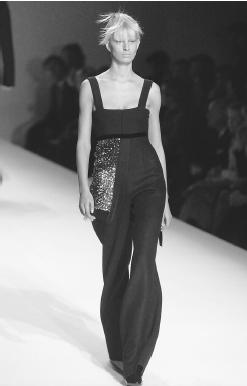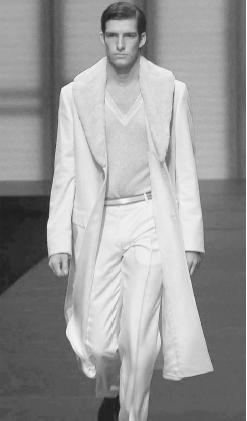Hugo Boss Ag - Fashion Designer Encyclopedia
German menswear fashion house
Founded: in Metzingen, Germany, by Hugo Boss in 1923, to manufacture work clothes and uniforms. Company History: Bought U.S.-based Joseph & Feiss, 1966; subsequently taken over by Siegfried Boss and son-in-law Eugen Holly (1948-72) and in 1972 by grandsons Jochen Holly and Uwe Holly; introduced men's and children's lines, 1948; began export to Belgium and Netherlands, 1973; Scandinavia and England, 1975; formed Paris subsidiary and began exporting to U.S., 1977; added men's shirts, 1981; exported to Canada, 1982; introduced sportswear and cosmetics line, 1984; added Italy, Japan, and Spain to export countries, 1985-86; created U.S. subsidiary in New York, 1986; Portugal, Taiwan, and Korea, 1987-88; launched eyewear collection, 1989; firm acquired by Japanese investment group Leyton House, Ltd., 1989; womenswear collection debuted and discontinued, 1990-91; bought by Italian manufacturer Marzotto & Figli, SpA (which became Gruppo Industriale Marzotto), 1991; formed units in Milan and Japan, 1991; Hugo and Baldessarini lines for men introduced, 1994; opened new stores in Prague and Shanghai, 1994; major media blitz and image rehaul, 1995; opened shop inside Saks Fifth Avenue, New York, 1996; sold Joseph & Feiss, 1996; launched Hugo womenswear, 1998; second womenswear line, under Boss label, announced 1999; Boss

Publications
On HUGO BOSS:
Articles
Syedain, Hashi, "What Suits Boss," in Management Today (London), June 1989.
"Modest Boss," in DNR, 25 January 1991.
Deeny, Godfrey, "The World According to Boss," in DNR, 1 April 1991.
Protzman, Ferdinand, "Hugo Boss: A Fading Status Symbol," in the New York Times, 23 June 1991.
Deeny, Godfrey, "Redirecting the Empire: Hugo Boss Adjusts to the 'Values' of the 1990s," in DNR, 5 August 1993.
Levine, Joshua, "I Am the Boss," in Forbes, 25 October 1993.

Laws, Malcolm, "Boss Cuts its Cloth to Suit the Modern Man," in the European, 22 December 1994.
"No Question Who's Boss," in DNR, 6 February 1995.
Gellers, Stan, "He's the Design Boss at Boss; Lothar Reiff is Busy Redesigning Boss Fashions and Image," in DNR, 13 March 1995.
Drier, Melissa, "Hugo to Start Chasing Generation X in October," in Women's Wear Daily, 26 May 1995.
Fisher, Andrew, "Hugo Boss Man Fashions Strategy for Expansion," in the Financial Times, 9 January 1996.
Palmieri, Jean E., "Brave New Boss Shop at Saks Flagship," in DNR, 15 August 1996.
"Hugo Boss USA Unveils Big Retail Expansion," in DNR, 26September 1996.
Ozzard, Janet, "Men's Star Hugo Boss Planning Major Entry into Womenswear in 1998," in Women's Wear Daily, 7 April 1997.
Palmieri, Jean E., "Hugo Boss USA Building Retail Empire," in DNR, 1 August 1997.
Bow, Josephine, "In Huge China Market, Early Arrivals Zegna and Hugo Boss Make Gains," in DNR, 4 January 1999.
Weisman, Katherine, "Hugo Boss: Big Plans in Womenswear," in Women's Wear Daily, 31 March 1999.
***
A company originally producing workwear in the 1920s, Hugo Boss segued successfully into suits for aspiring executives. In the 1960s Uwe and Jochem Holy, grandchildren of the company's founder, saw a place in the market for a mid-range version of the kind of fashionable clothes they enjoyed wearing from Pierre Cardin. Since then the continuing success of the company and the incursion of similar middle-market concerns into the European clothing industry has resulted in top German designers and fashion groups like Jil Sander, Mondi and Hugo Boss becoming international brand names.
Using new technology and the strategy of subcontracting, together with high quality materials, stringent quality control, and the business acumen of the company directors, Hugo Boss became a household name; acknowledging the powers of advertising, particularly the use of product placement, the company created an indelible image in the power dressing of the 1980s. Early in the decade, Boss became associated with the hard metropolitan chic of the ubiquitous yuppie, through male characters sporting a variety of Boss garments on television's Miami Vice and L.A. Law series.
The popular conception of the Filofax-toting, mobile-phone wielding entrepreneur living in a warehouse apartment, surrounded by matte black accoutrements, was conflated by the young (ish) European man with Hugo Boss suits, although in reality if the yuppie existed in great numbers he was far more likely to frequent Paul Smith or Armani. Nevertheless the sharp Boss suit, styled by businessmen rather than tailors, became symbolic of materialism and power for large numbers of European men, as increasing sales figures throughout the 1980s proved.
The Boss look, based on a traditionally masculine 20th-century silhouette, revolved around variations on the wide-shouldered suit, usually double-breasted with front pleated trousers; the Euroman added his own styling by rolling up the sleeves of the jacket á la Don Johnson. In the 1990s the Boss logo began appearing at prestigious sporting events, not so much because the company was interested in producing a line of sportswear to rival those of the German firms Puma and Adidas, but because of the glamorous image and athletic machismo associated with Formula One racing and Davis Cup tennis. This was subsequently reflected in the marketing of Boss Sport —"fragrance and bodycare for the confident man leading an active lifestyle."
The company responded well to the 1990s; export success remained constant, although for a time the name Boss was seen in Germany as somewhat downmarket due to overexposure. Rather than concentrating on export and weathering the storm, Boss responded by quickly withdrawing deliveries from a number of German retailers who no longer fit its standards, prepared to accept a loss of revenue rather than downgrading—a strategy which appeared to work as the firm very successfully went public. As for the image which seemed to be so squarely rooted in the 1980s? The suits gained more rounded shoulders but the advertising and brandnaming gave more of a clue— Europeans were introduced to a Boss man with "a new attitude and vision," seemingly encapsulated in a new fragrance and marketing angle, Boss Spirit.
Part of the "Boss Spirit" had to do with new chief executive Dr. Peter Littman, who took the reins in 1993. A shrewd businessman, Littman initiated a reorganization of the firm and its image. The old logo was tossed in favor of three new ones, each representing one of the menswear lines: Boss, the high-end sophisticated collection; Hugo, with the younger, trendier male in mind; and Baldessarini, for more luxurious, handmade menswear. By 1996 several new in-store boutiques were opening in high-end department stores; the first and largest, measuring in at 1,000 square feet, was built inside Saks Fifth Avenue's New York flagship store. Boss announced it would build 25 freestanding Boss stores along with another 50 in-store boutiques within the next five years. Handsome furnished stores opened in Los Angeles, Washington D.C., and Las Vegas in quick succession.
Surprisingly, Boss revisited womenswear in the late 1990s despite a dismal attempt back in 1990. The first collections, under the Hugo label for women aged 20 to 40, featured ready-to-wear and sportswear and followed on the heels of the latest fragrance launch, Hugo Woman, which had debuted in the U.S. in fall 1997. Another collection under the more exclusive Boss label was announced in 1999 along with the formation of a new subsidiary, Hugo Boss SpA, to deal solely with the Boss womenswear line, based in Milan. Additionally, the company had continued to expand its licensing program, with the Hugo Boss label on innerwear, loungewear, watches, footwear, and a major push into golf apparel.
While Hugo Boss had been an enduring and successful brand in Germany and Europe, the company's push for dominance in the U.S. through numerous retail outlets and aggressive advertising was paying off by 1998 and 1999. The same was true for China, where the firm had five stores at a time when there was little competition from fashion's leading menswear labels. Other than Ermenegildo Zegna, which had been in China since the early 1990s, and newcomer Giorgio Armani, few menswear producers had ventured to the country.
—Caroline Cox;
updated by Nelly Rhodes
Comment about this article, ask questions, or add new information about this topic: